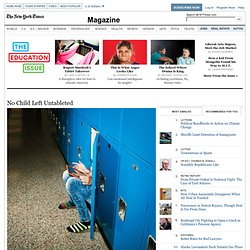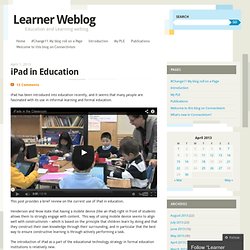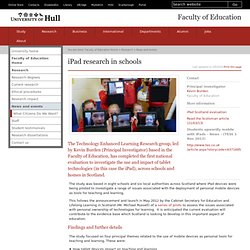

iPads in the Classroom – London Knowledge Lab report. Best of 2013 So Far... Studies of iPad Use In Education. We're half-way through 2013.

Studies of iPad Use in Education. The Early Results Of An iPad Classroom Are In. The following is from the November issue of the Edudemic Magazine for iPad. Click here to view the app in iTunes. My daily PLN reading seems to be full of stories about how to use iPads in the classroom. While this is certainly important information, I believe our Twitter feeds could use a few more stories about the positive impact the introduction of iPads are having in schools. Our school has been working with iPads for three years now and I can easily say that these have been the most exciting years of my educational career. A Small Collection of Studies of iPad Use in Education. No Child Left Untableted. Brian Finke for The New York Times There was, as educators say, a diverse range of learners in the room.

Some were well on the way to mastering the tablet. Ben Porter, for instance, a third-year teacher who previously worked as an operations manager for a Cold Stone Creamery franchiser, was already adept at loading and sharing lesson materials and using the tablet’s classroom-management tools: quick polls, discussions, short-answer exercises, the function for randomly calling on a student and more. Other teachers, including a gray-bearded man who described himself as “technologically retarded,” had not progressed much further than turning it on.
Smith, the most outspoken skeptic among the trainees, was not a Luddite — she uses her Web site to dispense assignments and readings to her students — but she worried about what might be lost in trying to funnel her teaching know-how through the tablet. The iPad as a Tool For Education - a case study. In the first two terms of implementing an iPad programme, Longfield Academy in Kent have noticed a great impact on teaching and learning.

Research carried out on behalf of Naace and supported by 9ine consulting is published here. It’s really exciting to be able to announce our research into the use of iPads. After a successful implementation at Longfield Academy in Kent and two terms of embedded use, the research shows some incredibly positive impacts on teaching and learning. 8 Studies Show iPads in the Classroom Improve Education. 8 Studies Show iPads in the Classroom Improve Education Posted by Ashley Wainwright on Mon, Feb 18, 2013 @ 09:26 AM Since their release in April of 2010, Apple’s iPads have taken the US by storm. iPads have swept through almost every industry, especially education.

iPad in Education. iPad has been introduced into education recently, and it seems that many people are fascinated with its use in informal learning and formal education.

This post provides a brief review on the current use of iPad in education. Henderson and Yeow state that having a mobile device (like an iPad) right in front of students allows them to strongly engage with content. This way of using mobile device seems to align well with constructivism – which is based on the principle that children learn by doing and that they construct their own knowledge through their surrounding, and in particular that the best way to ensure constructive learning is through actively performing a task. The introduction of iPad as a part of the educational technology strategy in formal education institutions is relatively new. It is only relatively recently that educational technology has been able to support a constructivist approach. I have got an iPad. This is how to Use iPad to Enhance Students Reading Skills.
iPad is still fascinating me with its huge potential in education.

After the Teachers Guide to The Use of iPad in Education and all the other posts I have published about iPad as a learning tool, I am trying today to explore some ways teachers can use this device to improve students reading skills. As you might have learned from the Teacher's iPad guide I posted earlier,there are many reasons why there is a growing educational focus on the iPad and most important of all these reasons are its portability feature and ease of use. I know it is too early to talk about iPad as a replacememnt of the tradional book but the speed at which schools and educational centres all around the world are embracing it is a clear omen that there will soon be a culture of digital eBooks and virtual libraries where access to books will be as easy as sending an email.
iPad Research in Schools. Last updated on 2/5/2014 Print this page1 The Technology Enhanced Learning Research group, led by Kevin Burden (Principal Investigator) based in the Faculty of Education, has completed the first national evaluation to investigate the use and impact of tablet technologies (in this case the iPad), across schools and homes in Scotland.

The study was based in eight schools and six local authorities across Scotland where iPad devices were being piloted to investigate a range of issues associated with the deployment of personal mobile devices as tools for teaching and learning. IPads in the classroom: The right way to use them, demonstrated by a Swiss school. Photo by Frederick Florin/Getty Images Touch-screen tablets for young students have become all the rage.

Some districts are even buying iPads for every kindergartner, a move sparking both celebration and consternation. Do we really want to give $500 devices to kids who can’t even tie their shoes? What are these schools doing with these devices, anyway? Last month, I had a rare opportunity to ask those questions at a school in Zurich, Switzerland.
ZIS, as the school is called, has distributed 600 iPads—one to every student in first through eighth grades, plus a set for teachers in preschool and kindergarten to use with children in small groups. I was wrong. The school has an unconventional take on the iPad’s purpose. One morning I watched first-graders taking assessments of what they understood about “systems.” Sam Ross, a second-grade teacher at ZIS, sees real potential in moments like this. Files.eric.ed.gov/fulltext/EJ990527.pdf. Files.eric.ed.gov/fulltext/EJ849719.pdf.